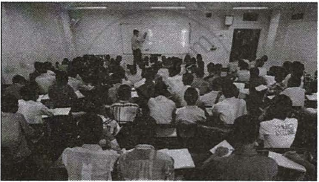Advertisements
Advertisements
प्रश्न
Solve for x and y:
`2x - 3/y = 9, 3x + 7/y = 2`
उत्तर
The given equations are:
2x - `3/y` = 9 ……..(i)
3x + `7/y` = 2 ……..(ii)
Putting `1/y` = v, we get:
2x - 3v = 6 …….(iii)
3x + 7v = 2 ……(iv)
On multiplying (iii) by 7 and (iv) by 3, we get:
14x - 21v = 63 ……..(v)
9x + 21v = 6 ……..(vi)
On adding (v) from (vi), we get:
23x = 69 ⇒ x = 3
On substituting x = 3 in (i), we get:
2 × 3 - `3/y` = 9
⇒6 - `3/y = 9 ⇒ 3/y`= -3 ⇒ y = -1
Hence, the required solution is x = 3 and y = -1.
APPEARS IN
संबंधित प्रश्न
Find the value of k for which each of the following system of equations has infinitely many solutions :
x + (k + 1)y =4
(k + 1)x + 9y - (5k + 2)
For what value of , the following system of equations will be inconsistent?
4x + 6y - 11 = 0
2x + ky - 7 = 0
Determine the values of a and b so that the following system of linear equations have infinitely many solutions:
(2a - 1)x + 3y - 5 = 0
3x + (b - 1)y - 2 = 0
Find the values of a and b for which the following system of equations has infinitely many solutions:
(2a - 1)x - 3y = 5
3x + (b - 2)y = 3
Show that the following system of equations has a unique solution:
2x - 3y = 17,
4x + y = 13.
Also, find the solution of the given system of equations.
Find the value of k for which the system of linear equations has an infinite number of solutions:
5x + 2y = 2k,
2(k + 1)x + ky = (3k + 4).
The sum of the numerator and denominator of a fraction is 4 more than twice the numerator. If the numerator and denominator are increased by 3. They are in the ratio of 2: 3. Determine the fraction.
a1x + b1y + c1 = 0 and a2x + b2y + c2 = 0, where a1, b1, c1, a2, b2, c2 are all real numbers and a12+ b12 ≠ 0, a22 + b22 ≠ 0, is called a ______.
Find the value(s) of p in (i) to (iv) and p and q in (v) for the following pair of equations:
– 3x + 5y = 7 and 2px – 3y = 1,
if the lines represented by these equations are intersecting at a unique point.
Read the following passage:
|
A coaching institute of Mathematics conducts classes in two batches I and II and fees for rich and poor children are different. In batch I, there are 20 poor and 5 rich children, whereas in batch II, there are 5 poor and 25 rich children. The total monthly collection of fees from batch I is ₹9,000 and from batch II is ₹26,000. Assume that each poor child pays ₹x per month and each rich child pays ₹y per month.
|
Based on the above information, answer the following questions:
- Represent the information given above in terms of x and y.
- Find the monthly fee paid by a poor child.
OR
Find the difference in the monthly fee paid by a poor child and a rich child. - If there are 10 poor and 20 rich children in batch II, what is the total monthly collection of fees from batch II?

